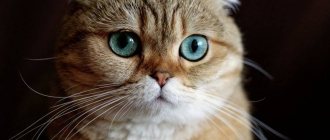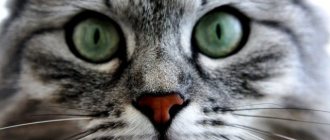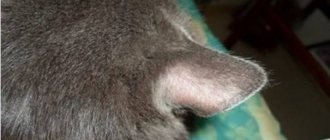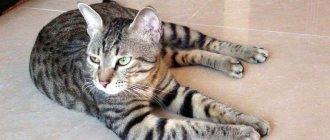A cat with eyes of different colors looks fascinating. Who would refuse such a pet, which arouses lasting interest and admiration among guests and acquaintances! People even start looking for a breed of cat with different eyes, not fully understanding the reason for such an unusual phenomenon.
I hasten to disappoint - such a breed does not exist. The good news is that kittens with different eyes can be found in any cat breed that accepts solid white or tortoiseshell.
Tricolor cat with different eyes
Author of the article: Olga Shiltsova, practicing veterinarian, author of the books “Dachshund of Fate” and “Tails of Fortune”
How is it that a cat has different colored eyes?
Different eye colors have a scientific name - heterochromia. Heterochromia occurs not only in cats, but also in dogs, horses, and even in humans (although it is a very rare occurrence in humans).
Complete heterochromia is when each eye is colored differently, and partial heterochromia is when two colors are combined in the iris of the eye. Partial heterochromia is truly rare, but a cat’s completely different eyes won’t surprise anyone.
Partial heterochromia
Partial or sectoral heterochromia
With complete heterochromia, one eye will always be blue, and the other - any color: yellow, green, orange. The secret is that blue eyes in cats are not a color at all, but its absence. That is, the color is genetically determined, but something prevented the pigment from migrating into the iris.
Complete heterochromia in a white cat
The distribution of pigment occurs while the kitten is still in the mother's womb. It is impossible to influence this process, nor can it be predicted. Therefore, breeding a “breed of cats with different eyes” is simply impossible.
White cat with heterochromia
Why does heterogeneity regularly occur in certain breeds or breeding lines? It's all white's fault! The gene for white color (it is called W - white) does not carry information about color, but simply suppresses all other colors. A snow-white cat may well give birth to colored kittens if she is secretly not white, but red or black. This white gene disrupts the flow of pigment into one eye - or both, as it turns out. That is, some kittens will have green or yellow eyes, some will have blue eyes, and some will have different ones.
Eyes of different colors are often found in white cats and cats.
Khao Mani
Another white cat with different eyes is Khao Mani. Kittens of this breed are commonly called “diamond eyes.” This breed of cat was bred in Thailand by order of the royal families, so the price of Khao Mani is quite high, and not everyone can buy it. This is especially true for representatives of the breed with different eyes. Thais are convinced that an odd-eyed cat can bring wealth, good luck and peace with tranquility to the house.
Khao Mani are short-haired cats with a small body size. Their main feature is the fear of loneliness, so they are extremely active and friendly. Cleanliness is also a hallmark of this breed, making them easy to care for.
From this video you will learn about the characteristics of the Khao Mani cat breed and how to care for them.
Does this affect the pet's health?
Eye color does not affect a cat's vision in any way. But if different eyes appeared under the influence of a dominant white gene, the cat may have hearing problems. The fact is that the W gene inhibits the migration of melanoblast cells not only into the iris, but also into the inner ear, disrupting the development of this organ.
This cat may be deaf in her left ear.
This is why white cats sometimes suffer from congenital deafness. Most often, the problem concerns blue-eyed animals (the effect of the gene is most pronounced), but contrary to popular belief, a white cat with colored eyes can also be deaf. If one eye is colored and the other is blue, then the cat may be deaf on the side of the blue eye, but can hear normally in the other ear. In this case, the owner is unlikely to notice any problem, and the cat’s hearing can only be checked using special tests under anesthesia in a veterinary clinic.
Pure white Maine Coon with heterochromia - possible deafness in the right ear
Deaf cats must be strictly rejected and are not allowed for breeding - this applies to any breed. In addition, you should not cross two white, blue-eyed individuals with each other, even if both the cat and the cat hear perfectly.
Save and increase
For a hundred years now, the Ankara Zoo has been running a program to breed white Angora cats with different or blue eyes.
At the beginning of the last century, unusual Angora cats found themselves in danger of extinction: the gene for long hair was actively used in the development of new breeds, and there were catastrophically few purebred Angoras left. In 1917, Turkey decided to preserve the breed as a national treasure, and for some time local animals were even prohibited from being exported abroad.
Now other white cats with different-colored eyes are bred in the world - and the British Shorthair breed is not lagging behind in this. For example, a nursery for odd-eyed Britons operates in Rotterdam.
Cat breeds with different eyes
So, there is no blue-eyed gene, no deafness gene, no different-eyed gene. Why does the Internet persistently offer some cat breeds as “different-eyed”? These are breeds where the snow-white color is:
- is the only valid one: kao-mani;
- very common: Turkish Angora;
- combined with colored spots: Turkish van.
Angora cat with different eyes
Turkish Van cat with heterochromia
Different eyes are often found in cat breeds for which white color is only an acceptable variety, and not the main breed characteristic. Breeders have a theory that to produce kittens with heterochromia, you need to cross white animals with bicolors.
Outbred black and white cat with different eyes
Bicolor color in Russian - two-color. Such animals are also called piebald: white spots alternate with colored areas. If there are a lot of white spots, then the cat may look completely white (a speck of color can be located on the tail or on the head). This white color is caused not by the W gene, but by the white piebald spotting gene - S (spot). The S gene also disrupts the migration of melanocytes to the fur and sometimes to the eyes, but does not cause deafness. Since the spots are characterized by asymmetry, it is not surprising if one eye is colored and the other is not.
It is the spotting gene S that is responsible for the color and heterochromia of the eyes in Turkish Vans, while in Kao Mani and Angora it is the dominant gene for white color W.
A Turkish Van cat with different eyes. The piebald S gene is responsible for color
There is another pattern: if a matched couple has a kitten (or several) with different eyes in their litter, then there is a high probability that in the next litters from these parents it will be possible to consistently produce kittens with heterochromia.
Thus, eyes of different colors can be found in cats of any breed, if white or spotted color is acceptable according to the standards - Cornish Rex, Sphynx, Maine Coon, Persian and exotic cats, British cats and many others.
White Cornish Rex with heterochromia
You should not discount ordinary mongrel cats - mestizos, in which heterochromia is also common. It must be said that a kitten with different eyes sharply increases the chances of finding a home - many are ready to take such an unusual pet, even if it is of “noble” blood. It is believed that cats with different eyes bring good luck to the owner and have strong magical powers. And even if you are far from esoteric, it is impossible to deny that cats with heterochromia look very impressive and mysterious.
Mongrel cat with different eyes
One of my friends even found a “bride” for his mongrel cat in the hope of getting an odd-eyed kitten. Unfortunately, the white Dobby (one eye is yellow, the other blue) and the white blue-eyed cat gave birth to kittens with the same yellow or blue eyes. Two of them were cream-colored, two were white - and both white kittens turned out to be deaf.
Mongrel cat with different eyes
Main breeds of odd-eyed cats
There are breeds for which different-colored eyes are more likely. This does not mean that heterochromia does not occur in other cats, but it is much less common in them.
Be sure to read:
Correspondence between the ages of cats and humans: methods of determination, stages of development by human standards
For pets with different colored irises, prolonged exposure to the sun is harmful due to the increased likelihood of cancer: in the summer, carefully monitor where they are.
When getting a cat of this type in areas with summer heat, the owner needs to lock it indoors during the daytime, since all cats love to lie in sunny places.
Turkish van
Turkish Van
A common breed of cat that has colored eyes. Half of its representatives have a special appearance. Cats with an original appearance are valued in Turkey, where they were awarded a monument.
Many animals have a special Van color, in which all the fur on the body is white, and there are dark markings on the face and head. Most often these spots are cream-colored, less often red or blue. Rarely found are Turkish Vans with multi-colored eyes, tortoiseshell in color with white spots. All color options are fixed by the standard.
The coat of the breed is soft and silky. Semi-long, it requires regular combing. The fluffy tail looks wide. The size of the animal is large.
The pet's character is sociable, so it needs constant attention from its owner. The cat follows the person, demands affection, and willingly participates in children's games.
The animal loves to sit on your lap and does an excellent job as a companion . Bouncing vans can easily be climbed onto refrigerators, cabinets, and mezzanines. With proper training, pets willingly bathe. The natural intelligence of Turkish Vans allows them to be trained by teaching them basic commands from a dog course.
Turkish Angora
Small cats, distinguished by their pleasant nature and soft-to-touch fur, often have multi-colored irises. Pets may have different colors, but they have the same probability of heterochromia.
Turkish Angora
Most bicolor cats are deaf. The stable immunity of animals simplifies their maintenance and significantly reduces the risk of infectious diseases, even if the pets go out for walks.
Be sure to read:
How cats treat people: 4 ways, basic rules, what breeds, what diseases they get rid of
Representatives of the breed are playful and highly demanding of attention. Because of this, when getting such a pet, you cannot leave it alone for a long time. The solution for owners who spend the day at work is to buy two kittens (preferably from the same litter), which will fully satisfy the need for communication in each other’s company.
Khao-mani
Khao Mani
A short-haired white breed native to Thailand. She is rare and the kittens are expensive. Finding them is not easy. The eyes of representatives of the breed often have an iris of two colors and look especially unusual.
The character of the animal is capricious. You cannot keep a cat and leave it alone for a long time. Clean, they quickly get used to the tray. Low activity allows you to place your pet in a small apartment.
And so it happens: two cats merge into one
There is another reason why a cat may have an extravagant color (like the two-faced cat Venus, for example) or eyes of different colors.
A rare phenomenon: a cat of a normal color with heterochromia
Cats are prolific animals. It occasionally happens that two fertilized eggs, instead of quietly and peacefully attaching to the wall of the uterus and developing further, merge into one. This results in one healthy, viable kitten, but with a double set of chromosomes. This phenomenon is called chimerism.
The fusion of embryos sounds quite creepy, but in fact, such animals live peacefully, bear offspring, and no one even suspects what an unusual creature they have sheltered at home. A cat cannot be considered a chimera only on the basis of a strange color; confirmation requires genetic tests (which no one is in a hurry to perform).
This cat's different colored eyes may be the result of an eye injury.
Mosaicism can also occur in cats - areas of cells with differences in DNA resulting from mutation. Mosaicism is often “to blame” for the appearance of areas of fur of “impossible color,” partial heterochromia of the eyes, and complete heterochromia in tortoiseshell and colored cats. The difference between a mosaic and a chimera is that mosaic mutations occurred on the basis of their own cells, while a chimera has two complete and different sets of chromosomes that have not undergone mutation.
It makes sense to suspect such deviations if the cat has eyes of different colors, but none of them are blue. For example, one is yellow or orange, the other is green. Also interesting are the variants of heterochromia in completely colored cats - this is much less common than in white animals, but it still happens!
Types of heterochromia eyes
A kitten with different eyes is an example when heterochromia is inherited.
Veterinarians distinguish the following types of eye heterochromia:
- complete, when the entire iris is in a pigment of a color different from the shade of the other eye;
- sectoral, when one of the sections differs from the entire pupil;
- ring heterochromia, in which a pronounced circle of a different color from the main color is formed on the iris.
Eye pigmentation has blue-blue, green, yellow-brown shades. Sometimes they harmonize with the coat color, sometimes this is a sign of the breed.
At what age can you determine the different eye colors of a kitten?
If previously heterochromia was considered a genetic anomaly and the appearance of such kittens was not welcomed, now everything is just the opposite. Breeders are struggling to unravel the genetic algorithms that are responsible for the eye color of cats, and kittens with heterochromia are desired and in demand.
But when kittens first open their eyes, they all have the same “baby” blue color.
This baby has one eye darker than the other - heterochromia may be suspected
The accumulation of pigment in the iris occurs gradually, and eye color changes with age. Heterochromia can be reliably determined at 2.5-3 months.
Experienced cat breeders, however, know that you can find out eye color even earlier. To do this, kittens are examined in a dark room with a weak light source. Blue eyes glow red, and the rest glow green.
This Turkish Van kitten is 1 month old - and it’s already clear that his eyes will be different colors
Health of cats with heterochromia
Owners of pets with different-colored eyes need to remember the following nuances of furry health:
- If a blue eye suddenly turns red, your cat most likely has a bruise. The veterinarian will diagnose a broken vessel or hematoma, which should only be treated under the supervision of an experienced doctor.
- The color of the eye can change if melanoma grows or another neoplasm appears, a tumor located in the eyeball or fundus. Not every veterinarian is able to make an accurate diagnosis, so if you do not trust one doctor, consider him insufficiently competent, and the treatment does not give visible positive results, do not be afraid to consult another veterinarian.
Concomitant deafness
White cats with different eyes have an unusual appearance, but such beauty has a downside - serious hearing problems. As practice shows, most of the differently-eyed pets have poor hearing or are completely deaf. Moreover, most often the ear located on the side of the blue eye has poor hearing.
Such animals often have hearing problems
This disorder is due to genetic reasons and the effect on the body of the W gene, which is responsible for white color. Its excess is not only responsible for white fur, but also blocks the production of hearing aid cells, which is why kittens have poor hearing from birth.
Despite their deafness, cats with heterochromia are not much different from their counterparts. Such pets do not require special maintenance measures and also need the care and love of the owner. Since the most powerful organ of perception of the surrounding world in such cats is the eyes, the owner needs to regularly wipe the eyes with a sterile cotton pad and monitor their health.











